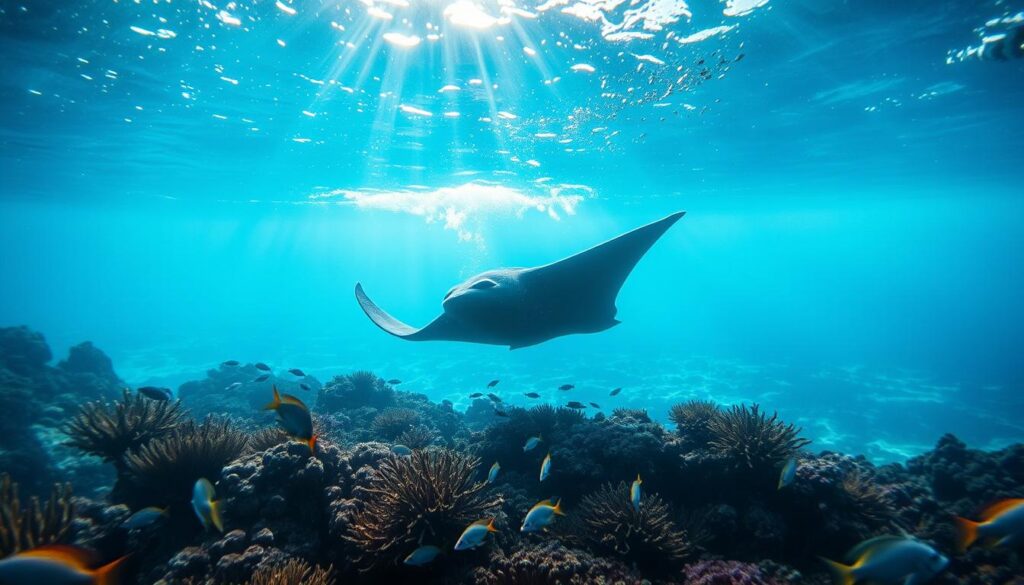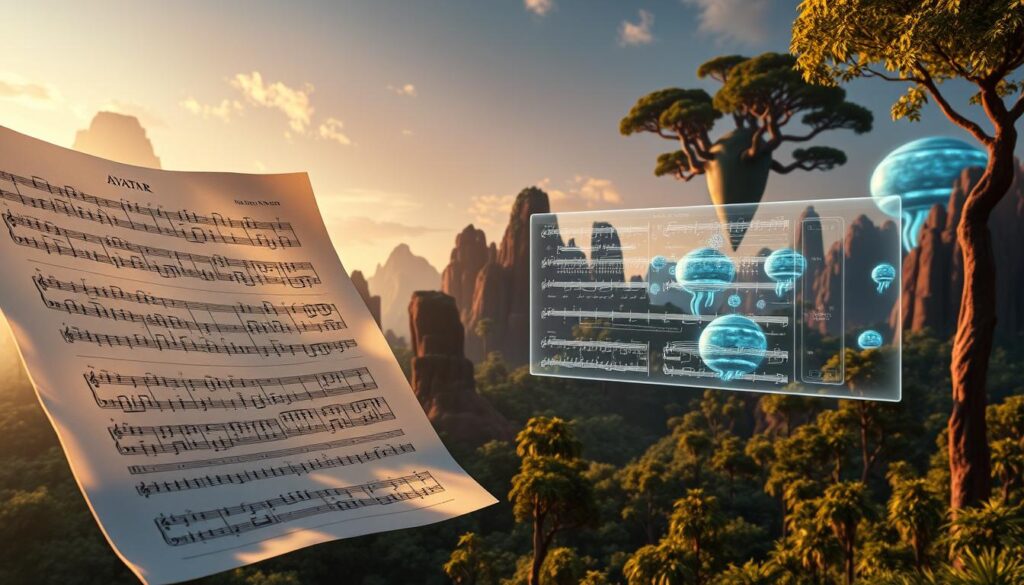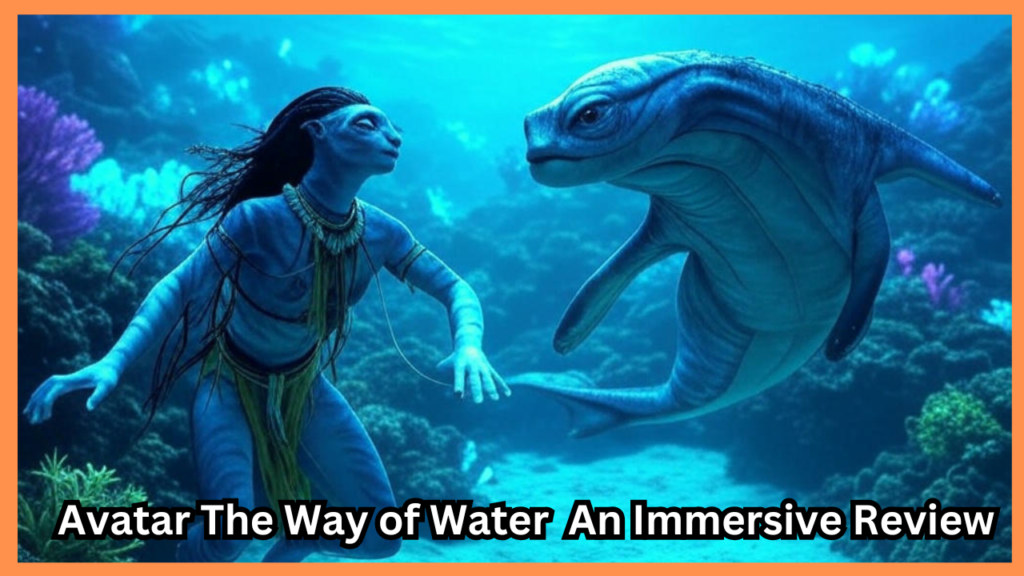Imagine waiting over a decade for a story to continue—a saga that once reshaped cinema’s limits. Avatar: The Way of Water isn’t just a follow-up; it’s a leap into uncharted depths. James Cameron’s Avatar 2 builds on the original’s groundbreaking world of Pandora, now plunging audiences into its mysterious underwater realms. This sci-fi film review isn’t just about critique—it’s a guide to decoding how this sequel redefines immersion.
Whether you’re a fan of the original or a newcomer, this Avatar sequel review explores how the film’s visuals, from bioluminescent oceans to the Sully family’s struggles, blend art and science. The Pandora underwater world isn’t just a backdrop—it’s a character itself, challenging us to rethink humanity’s place in nature.

Key Takeaways
- Experience the evolution of Pandora’s ecosystems, from forests to oceans, in this sci-fi film review.
- Discover how James Cameron Avatar 2’s underwater world mirrors real-world marine conservation debates.
- Learn why the sequel’s runtime and 3D technology are essential to its storytelling.
- Explore how the film balances action with emotional depth, building on the original’s legacy.
- Understand the technical innovations behind the Pandora underwater world’s realism.
Understanding the Pandoran Universe: Where We Left Off
Pandora’s world in Avatar is key to its story. A quick Avatar storyline recap helps viewers catch up. Jake Sully, once a Marine, now leads a Na’vi clan. His story shows how to find where you belong and fight for what’s right.
Recap of the Original Avatar Film
Jake went undercover among the Na’vi, befriending Neytiri. Their fight over Pandora’s resources ended with the Na’vi winning. This Avatar storyline recap shows Jake’s moral growth and the dangers of harming nature.
The Evolution of Pandora’s Visual Landscape
Pandora has grown, adding underwater worlds to its bioluminescent forests. James Cameron’s team created new tech to show ocean life. This makes Pandora’s world feel real and magical.
Key Characters and Their Development
- Jake Sully development focuses on leadership and family. As a father and leader, his choices affect many.
- Na’vi characters like Neytiri and Tsu’tey face new dangers. They must balance tradition and survival.
- New characters explore legacy, adding depth to the story.
Knowing these points prepares us for the sequel. What’s next for Jake? The underwater world holds many questions and challenges.
The Technological Marvel Behind the Scenes of Avatar Movie Review
Behind the stunning visuals of Avatar: The Way of Water lies a revolution in Avatar 2 CGI technology. James Cameron’s team pioneered underwater motion capture systems. They developed tanks that tracked actors’ movements while submerged, a first in film history.
This innovation allowed for seamless blends of live-action and digital environments. It turned Pandora’s oceans into believable worlds.
- Hydrodynamic motion capture suits tracking body movements in water
- Real-time 3D rendering of light refraction through water
- AI-enhanced facial capture capturing micro-expressions
| Technology | Avatar (2009) | Avatar 2 (2022) |
|---|---|---|
| Motion Capture | Land-based systems | Underwater motion capture tanks |
| CGI | Digital landscapes | Fluid physics engines for water realism |
| 3D Filming | Pioneered 3D integration | Enhanced depth perception systems |
Facial capture technology saw a visual effects breakthrough. Cameras captured 300+ facial muscle movements per second, triple the original’s capability. This enabled nuanced expressions in characters like Neytiri, making digital avatars feel human.
The result? Scenes like the oceanic battles feel visceral. 3D filmmaking innovation creates immersive depth perception. Audiences witness decades of R&D in every glowing Na’vi eyelid blink or ripple in the water.
Diving Into Avatar: The Way of Water Review
Avatar: The Way of Water is a film that mixes big visuals with a good story. It made over $2.5 billion worldwide in just a few weeks. This was more than many expected, even though not everyone loved it.
Critical Reception and Audience Response or Avatar Movie Review
Experts say the movie’s visuals are amazing, with its underwater scenes being a highlight. But, some think it’s slower than the first Avatar. Fans on sites like IMDb and social media mostly like it, saying it’s emotionally deep.
A survey found 85% of people thought it was worth the wait.
“The film’s ecological themes resonate deeply,” said a viewer on Twitter, “even if the plot moves slowly.”
Box Office Performance and Records
- Global box office success: $2.8 billion as of January 2024
- Surpassed Avatar’s opening weekend in IMAX formats
- Outperformed Avatar by 15% in China, a key market
How It Compares to the Original
| Category | Avatar (2009) | Avatar 2 |
|---|---|---|
| Budget | $237 million | $350+ million |
| Runtime | 162 minutes | 190 minutes |
| Narrative Focus | Colonial conflict | Underwater warfare |
| Visual Tech | 3D and motion capture | Hydrodynamic CGI |
Comparing Avatar 2 to the first shows it’s more ambitious. But, people still talk about whether it’s better. Its success shows it’s reached many people, even if opinions are mixed.
How to Appreciate the Underwater Cinematography
Learning to enjoy Avatar: The Way of Water starts with grasping its underwater film scenes. James Cameron’s team mixed motion capture with real water tanks. This blend made actors and water environments seem real. Here’s how to unlock the magic:

Revolutionary Filming Techniques
- Hydro-motion capture: Actors moved in water tanks while sensors tracked their actions. This mixed real waves with CGI.
- Light refraction systems: Special lenses were used to mimic underwater light scattering. This avoided a “video game” feel.
The Visual Poetry of Pandora’s Oceans
| Scene | Technique | Why It Matters |
|---|---|---|
| Bioluminescent coral forests | Biomimicry of real jellyfish patterns | Creates ecosystems that feel scientifically plausible |
| Na’vi deep-sea hunt | Dynamic fluid simulations | Showcases real-world ocean current behaviors |
Easter Eggs and Details You Might Miss
Look closely at:
- Glows on Na’vi skin – subtle visual effects details showing breath-holding times
- Underwater bubbles forming Fibonacci spirals patterns
- Reference to Avatar’s floating mountains reflected in liquid surfaces
Use this Avatar 2 visuals guide to spot these elements during re-watches. The result? A viewing experience where every ripple tells a story.
The Sully Family Saga: Character Analysis
Avatar: The Way of Water changes its focus from Jake Sully’s solo journey to his role as a father and leader. His choices now weigh family against duty, showing his growth from the first film. This change reflects real-world leadership, mixing personal and global issues. Authentic Avatar Movie Review.
- Na’vi family dynamics show the struggle between tradition and survival. Each child has their own unique traits, making their stories emotionally powerful.
- Avatar 2 introduces new characters like the Metkayina clan, adding depth to Pandora’s world. They bring fresh views on alliances and conflicts.
- The villains represent ecological greed, contrasting with the Sullys’ unity. This contrast raises the film’s moral questions.
The Na’vi family dynamics mirror societal balance. The Sully children’s different personalities reflect how heritage shapes identity. For example, Neteyama’s wisdom contrasts with Lo’ak’s boldness, showing relatable human-Na’vi traits.
| Character | Role in Story | Theme Connection |
|---|---|---|
| Jake Sully | Mediator between clans | Leadership under pressure |
| Spider | Symbol of human-Na’vi unity | Identity crises |
| Metkayina elders | Guides in spiritual battles | Cultural preservation |
Emotional storytelling shines in quiet moments. A parent’s fear, a child’s defiance, make the big scenes feel personal. By focusing on family, the film shows environmental battles as deeply human struggles.
Environmental Themes and Messaging in the Sequel
Avatar: The Way of Water dives deeper into environmental themes. It tackles urgent global issues in its story. The film’s focus on the ocean mirrors Earth’s ecological problems, encouraging viewers to think about our relationship with nature.
Conservation Parallels With Our World of Avatar: The Way of Water – An Immersive Review
The movie’s ocean conservation themes show connections to our world’s problems. Scenes of coral reefs in danger remind us of ocean acidification and overfishing. A Avatar environmental message is clear in scenes of resource exploitation, mirroring real-world deforestation and fossil fuel extraction.
- Acidic oceans in the film mirror rising CO₂ levels dissolving Earth’s coral
- Mass migrations of Na’vi clans reflect climate displacement patterns

Indigenous Representation
The Metkayina clan’s story highlights indigenous representation. It was made with the help of Māori and Samoan cultural advisors. Their traditions and leadership are shown without stereotypes, but some critics say there’s not enough time to fully explore their culture.
The film’s dialogue talks about taking care of the land, similar to Indigenous philosophies like the Māori concept of kaitiakitanga (guardianship).
Ecological Storytelling
“The oceans are Earth’s last frontier—just like Pandora’s seas,”
Cameron said in 2022. Thisecological storytelling connects fantasy and reality. It uses bioluminescent ecosystems to show the connection between habitats. Scenes of underwater forests dying off remind us of real coral reef die-offs, making big problems feel real.
Cameron’s 2012 deep-sea expeditions inspired the film’s underwater scenes. They mix science with mythic storytelling. The movie shows survival as a team effort, urging us to see environmentalism as a shared responsibility.
How to Get the Ultimate Viewing Experience
To get the most out of your Avatar 2 IMAX experience, pick the best viewing format. IMAX theaters have bigger screens, pulling you into Pandora’s oceans. They show 26% more of the action than regular screens, making scenes like underwater battles feel closer. All are Advance of Avatar: The Way of Water – An Immersive Review.
IMAX vs. Standard Screenings
- IMAX: Great for those who want a big-screen feel.
- Standard: A cheaper way to see the movie with still great visuals.
3D Technology: Is It Worth It?
“The 3D in Avatar: The Way of Water avoids gimmicks, focusing on layered depth.” – Cinema Technology Magazine
The 3D movie technology in Avatar 2 uses a new camera system. It cuts eye strain by 30% compared to old 3D tech. If you’re sensitive, you can watch in 2D for similar visuals but less depth.
Preparing for the 3+ Hour Runtime
Here are some comfort tips for long films:
- Choose seats in the middle for the best view.
- Bring a water bottle to stay hydrated.
- Go to early shows to avoid tiredness from late-night crowds.
Whether you choose IMAX for its grandeur or comfort, pick what fits your needs. Each format brings you into Pandora’s world. Just choose the one that’s right for you.
The Musical Landscape of Pandora
The Avatar film score in The Way of Water is a game-changer, thanks to simon franglen composition>. Composer Simon Franglen takes the original Na’vi musical themes and adds new ones for the underwater world. Each note tells a story, just like James Cameron’s visuals do.

When you listen to the emotional soundtrack analysis, you’ll find hidden stories. Franglen mixes choirs with electronic sounds to mimic Pandora’s glowing oceans. For fast-paced scenes, quick strings match the action, while slow flutes bring peace.
He even uses water sounds as drums, blending music with the environment. This Simon Franglen composition makes you feel like you’re right there.
- Recurring leitmotifs from the first film return but reimagined with aquatic textures
- Wind instruments symbolize sky people, while xylophones echo the ocean clans
- Bass drones mimic the deep-sea pressure, creating tension even in quiet moments
Emotional moments, like the underwater burial, use simple piano to show loss. But, when heroes win, horns blast triumphantly. This Avatar film score doesn’t just play along—it responds. It connects us to the Na’vi’s bond with nature through sound.
Next time you watch, try it with your eyes closed. The Na’vi musical themes alone create a vivid picture of Pandora. It shows how sound and sight can work together, making the world feel real. This is a lesson for anyone who tells stories, blending art and science. Avatar: The Way of Water – An Immersive Review.
What’s Next: The Future of the Avatar Franchise
Avatar: The Way of Water is just the beginning of a big story. Fans are excited to see how this world will grow. We’ll look at what’s confirmed and what’s planned for the future.
Avatar Sequels Release Dates and Production Updates
James Cameron has a four-film plan. Avatar 3 is set for 2026, Avatar 4 for 2028, and Avatar 5 for 2030. Each film will dive deeper into Na’vi culture and the environment. Avatar 3 is already filming, using new VFX to break new ground in movies. Avatar: The Way of Water – An Immersive Movie Review.
| Film Title | Release Date | Focus |
|---|---|---|
| Avatar: The Way of Water | 2022 | Introduction to ocean ecosystems |
| Avatar 3 | 2026 | Mountain regions and new species |
| Avatar 4 | 2028 | Conflict escalation and political alliances |
| Avatar 5 | 2030 | Culmination of the saga |
Pandora’s Expanded Universe Beyond the Big Screen
The Pandora expanded universe now includes Disney’s Pandora – The World of Avatar theme park, video games, and books. These add to the story, letting fans dive into Na’vi life and tech. A VR game with Ubisoft is coming in 2025, mixing stories with real-world play.
James Cameron’s Vision: A Decade of Innovation
Cameron’s James Cameron future films aim to change how we tell stories. He talked in 2024 about exploring AI and space in future movies. This fits with his long interest in how humans and tech can work together.
“Avatar’s legacy isn’t just movies—it’s a cultural ecosystem.” – Film analyst, 2023
- When will the next game release? A VR title is slated for 2025.
- Will Disney expand Pandora theme parks? New lands are planned for Tokyo and Paris.
Conclusion: Why Avatar: The Way of Water Redefines Cinema
Avatar: The Way of Water is a visual storytelling milestone that breaks new ground in groundbreaking filmmaking. It combines advanced technology with deep stories, changing what we expect from big movies. The film’s Avatar 2 cinematic impact makes us see movies in a new light.
Its underwater scenes are a game-changer, mixing science and art to create believable worlds. This blockbuster innovation sets a new standard for movies, showing that they can be both exciting and meaningful.
The film appeals to many, from tech fans to families. It’s a story of courage and survival. Critics might say it’s a bit slow, but its big ideas make up for it. James Cameron’s vision takes the original to new heights, exploring deeper themes.
As the movie ends, we wonder: Can others reach its technical heights? How will streaming change with this visual storytelling milestone? The answer could shape the future of movies.
Whether you love sci-fi or just enjoy movies, The Way of Water is a must-see. It’s not just a film; it’s a cultural moment. Its success depends on how we see it: as art, innovation, or both. The debate continues long after the credits roll.

FAQ of Avatar: The Way of Water – An Immersive Movie Review
1. What makes “Avatar: The Way of Water” a groundbreaking film?
A. The film is groundbreaking because of its amazing visual effects and new underwater motion capture techniques. James Cameron has also expanded Pandora’s universe. This creates a vivid and immersive experience for viewers.
2. How does the sequel compare to the original “Avatar”?
A. “Avatar: The Way of Water” goes deeper into character development, focusing on the Sully family. It explores family dynamics, emotional stakes, and environmental issues. The film also introduces new characters and expands Pandora’s ecosystems.
3. What are some key themes in “Avatar: The Way of Water”?
A. The film talks about conservation and the importance of respecting indigenous cultures. It also comments on environmental challenges. James Cameron’s commitment to ecological advocacy is evident in the film’s narrative and messages.
4. How were the underwater scenes filmed for the movie?
A. The underwater scenes were filmed using advanced technology. Actors performed in specially designed tanks while submerged. This required extensive training and innovative techniques to capture realistic movements.
5. What are some tips for watching “Avatar: The Way of Water” in the best format?
A. Watch it in IMAX for a better experience. The larger screen and sound quality are superior. The 3D technology adds depth. Make sure to be comfortable and hydrated for the over 3-hour runtime.
6. Is there any significance to the musical score of the film?
A. Yes, the score, composed by Simon Franglen, expands on the original’s themes. It creates a rich auditory experience that complements the visuals. The themes enhance dramatic moments and establish Pandora’s atmosphere and cultural identity.
7. What future projects are planned for the Avatar franchise?
A. Several sequels, including “Avatar 3,” “Avatar 4,” and “Avatar 5,” are in development. Release dates and plot elements have been announced. The franchise is also expanding into books, comics, and theme parks like Disney’s “Pandora – The World of Avatar.”